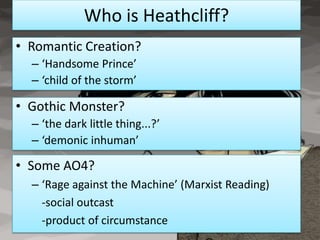
Wuthering Heights: Heathcliff
- 1. Who is Heathcliff? • Romantic Creation? – ‘Handsome Prince’ – ‘child of the storm’ • Gothic Monster? – ‘the dark little thing...?’ – ‘demonic inhuman’ • Some AO4? – ‘Rage against the Machine’ (Marxist Reading) -social outcast -product of circumstance
- 2. Romantic Creation • Heathcliff – ‘displays the battle between traditional moral criteria and the claim that sheer vitality of being is superior to conventionality of being’ (Cedric Watts, 1988) • “Its better to burn out, than fade away” (Neil Young, 1979) • “as he had no surname, and we could not tell his age, we were obliged to content ourselves with the single word, ‘Heathcliff’” (p330)
- 3. ‘Handsome Prince’ • “You’re fit for a prince in disguise. Who knows, but your father was Emperor of China, and your mother an Indian Queen, each of them able to buy up, with one weeks income, Wuthering Heights and Thrushcross Grange together”. • Fairy Tales are Romantic? – Concerned with romance and love – Handsome Princes are physically alluring and ‘charming’ • Fairy Tales are Gothic? – Disguise and mystery can be subversive – Fairy Tales are violent and horrific
- 4. Child of the Storm • ‘A natural force which has been frustrated of its natural outlet, so that it inevitably becomes destructive; like a mountain torrent diverted from its channel’ (David Cecil, 1934) • ‘A tendency to charge the landscape with emotions that echo those of the characters that populate it ... Is one of the most notable features of Wuthering Heights’ (Peter Hyland, 1988)
- 5. • ‘The grim and forbidding Yorkshire moors, hostile as they are to human activity ... Provide an ideal setting for a grim story’.
- 6. A wild nature and being un-reclaimed – is fundamental to his character. • Tell her what Heathcliff is – an unreclaimed creature, without refinement – without cultivation; an arid wilderness of furze and whinstone (Catherine warns Isabella) Bronte draws on the hardest, most elemental forms of nature to characterise Heathcliff. The metaphors containing ... -The thorny hostility of gorse ‘furze’ -The absolute hardness of stone ... does the work of a mass of adjectives
- 7. What’s in a name...? Heath Cliff Get it????
- 8. Gothic Monster • ‘In Gothic narratives, a central figure is commonly the charismatic villain...’ (Cedric Watts) – Mysterious – Saturnine (dark and moody) – Brooding – Powerful – Ruthless – Sexually menacing – Tyranical
- 9. ‘This dark little thing....’ ‘a night-creature gripped by dark or evil ambitions’ (Cedric Watts) ‘... children of the night’ (Dracula, Stoker 1890)
- 10. Biblical Rejection – c.f. Prodigal Son. - Going against God – Prometheus, Satan, Frankenstein -A Classic Gothic Archetype. • “I felt that God had forsaken the stray sheep there to its own wicked wanderings, and an evil beast prowled between it and the fold, waiting his time to spring and destroy” (Nelly doesn’t like the ‘new’ Heathcliff on his return, p146) Wicked, evil, beast – the diction of villainy Prowl, spring, destroy – the verbs of a lurking menace
- 11. Demonic Inhuman? • ‘I have no pity! I have no pity! The more worms writhe the more I yearn to crush out their entrails! It is moral teething, and I grind my teeth with greater energy, in proportion to the increase of pain’ (p189) – Focus on Horror (physical suffering) as opposed to Terror (mental aguish) – Heathcliff appears almost like the classic ogre from earlier Gothic texts and Fairy Tale.
- 12. Nice Guy? – - Love for Catherine - ‘rudely confessed regard for Hareton’ - ‘half-implied esteem for Nelly Dean’ - ‘These solitary traits omittted, we should say he was ... a man’s shape animated by demon life – a Ghoul’ (Charlotte Bronte 1850)
- 13. A Ghoul?? • Remind you of anybody??
- 14. Some AO4? Yes, plea se!
- 15. Social Outcast and Misfit • Heathcliff – appears in a rural economy – mouthing ‘gibberish, that nobody could understand’ – racially distinct ‘dark little thing’ • Heathcliff ‘proletarian offspring of industrial Liverpool’ (Peter Miles, 1990) Marxist Reading
- 16. “Heathcliff ... You may come and wish Miss Catherine welcome, like the other servants” Hindley characterises Heathcliff as a ‘class’. “They entirely refused to have it in bed with them, or even in their room ... so I put it on the landing of the stairs, hoping it might be gone on the morrow” Nelly’s use of the pronoun ‘it’ to describe Heathcliff defines him as ‘the other’, as removed from the culture of the Earnshaw household.
- 17. • “He has no social or domestic status, and he is therefore both a threat to the established order and an opportunity for it to be reinvented” (Terry Eagleton, 1975) More Marxism
- 18. Now write the essay ... • Clear Structure (A01) • Consistent use of quotation (A02) • A discussion of the form of the novel (AO2) • Reference to other texts (AO3) • Use Critical Quotations (AO3 / 4) • Give alternative readings (AO4) • Discuss Screen adaptations (AO4)